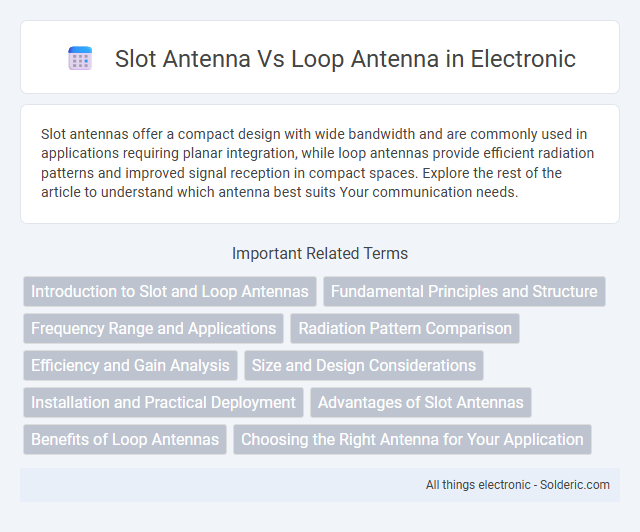Slot antennas offer a compact design with wide bandwidth and are commonly used in applications requiring planar integration, while loop antennas provide efficient radiation patterns and improved signal reception in compact spaces. Explore the rest of the article to understand which antenna best suits Your communication needs.
Comparison Table
| Feature | Slot Antenna | Loop Antenna |
|---|---|---|
| Structure | Metal surface with a narrow slot cut out | Conductive loop of wire or tubing |
| Radiation Pattern | Directional, broadside to the slot | Omnidirectional (small loops) or directional (large loops) |
| Frequency Range | Primarily UHF and microwave frequencies | VLF to HF bands |
| Polarization | Linear polarization, dependent on slot orientation | Variable: can be linear or circular depending on feed |
| Size | Compact, matched to wavelength of slot | Variable size, generally larger for low frequencies |
| Applications | Radar, satellite, microwave communication | Direction finding, AM radio, magnetic field sensing |
| Impedance | Typically 300-400 ohms | Variable; often low impedance (tens of ohms) |
| Advantages | High directivity, compact design, durable | Simple construction, sensitive to magnetic fields |
| Disadvantages | Requires precise construction, narrow bandwidth | Low radiation resistance, high loss at high frequency |
Introduction to Slot and Loop Antennas
Slot antennas feature a narrow slot cut into a metal surface, radiating electromagnetic waves through the aperture, making them ideal for applications requiring compact, low-profile designs. Loop antennas consist of a wire or conductor shaped in a loop, generating magnetic fields mainly used for direction finding and signal reception at lower frequencies. Your choice depends on factors like frequency range, size constraints, and radiation pattern preferences.
Fundamental Principles and Structure
Slot antennas operate based on the principle of electromagnetic wave radiation through apertures cut in a conductive surface, typically featuring a narrow slot etched into a metal plate that acts as a resonant cavity. Loop antennas consist of a closed conducting loop or coil where the magnetic field generates radiation, with their structure varying from small loops for magnetic field sampling to large multi-turn loops enhancing sensitivity and bandwidth. Both antennas utilize fundamentally different mechanisms--slot antennas rely on electric field discontinuities, while loop antennas depend on magnetic flux, which defines their distinct radiation patterns and impedance characteristics.
Frequency Range and Applications
Slot antennas operate effectively across UHF to microwave frequencies, commonly ranging from 300 MHz to several GHz, making them ideal for radar systems, satellite communications, and wireless networks. Loop antennas typically function at lower frequencies, from LF through VHF (30 kHz to 300 MHz), and are widely used in direction finding, AM radio receivers, and RFID systems. The choice between slot and loop antennas depends largely on the intended frequency band and application requirements, with slot antennas favoring high-frequency, directional use and loop antennas suited for low-frequency, omnidirectional reception.
Radiation Pattern Comparison
Slot antennas exhibit a broadside radiation pattern with maximum radiation perpendicular to the slot, providing a directional beam ideal for applications requiring focused energy. Loop antennas, especially small loops, generate a figure-eight pattern with nulls perpendicular to the plane of the loop, offering bidirectional radiation primarily in the plane of the loop. The key difference lies in the slot antenna's linear polarization and directional gain contrasted with the loop antenna's typically lower gain and magnetic field dominance in radiation.
Efficiency and Gain Analysis
Slot antennas typically exhibit moderate efficiency with gains ranging from 5 to 8 dBi, benefiting from their planar structure that minimizes losses. Loop antennas often have lower gain, generally below 3 dBi, but can achieve high efficiency when constructed with low-resistance conductors and designed for resonance. Your choice depends on whether higher gain or smaller size and omnidirectional patterns are more critical to the application.
Size and Design Considerations
Slot antennas typically offer a more compact and planar design, making them ideal for applications requiring low-profile and space-efficient solutions, such as in aircraft and mobile devices. Loop antennas, often larger and bulkier due to their circular or rectangular conductive loops, are designed for robust magnetic field reception and transmission, suitable for low-frequency operations. Size constraints in slot antennas drive design towards precise slot dimensions and shapes, while loop antennas focus on the perimeter length and conductor thickness to optimize performance.
Installation and Practical Deployment
Slot antennas offer ease of installation in compact spaces due to their flat, planar design, making them ideal for embedded applications on metal surfaces. Loop antennas require more careful positioning and support structures to maintain their shape and optimal radiation patterns, often needing clearance around the loop for efficient deployment. Your choice depends on the installation environment's spatial constraints and the desired antenna performance characteristics.
Advantages of Slot Antennas
Slot antennas offer compact design and easy integration into metal surfaces, making them ideal for applications requiring low-profile structures. Their wide bandwidth and stable radiation patterns provide superior performance in communication systems. Enhanced polarization diversity and resistance to environmental effects further contribute to their reliability over loop antennas.
Benefits of Loop Antennas
Loop antennas offer superior directional sensitivity and noise reduction compared to slot antennas, making them ideal for precise signal reception in crowded frequency environments. Their compact size and ability to operate efficiently at lower frequencies provide flexibility in antenna placement and design. You benefit from enhanced signal clarity and reduced interference, especially in applications requiring narrow bandwidth and high selectivity.
Choosing the Right Antenna for Your Application
Slot antennas offer high directional gain and compact size, making them ideal for applications requiring narrow beamwidth and precise targeting, such as radar and satellite communication. Loop antennas provide omnidirectional coverage with simplicity and wide bandwidth, suitable for applications like AM broadcasting and RFID systems. Selecting the right antenna depends on factors like frequency range, radiation pattern, size constraints, and environmental conditions to optimize performance and reliability.
slot antenna vs loop antenna Infographic

 solderic.com
solderic.com